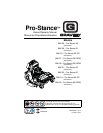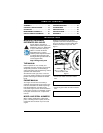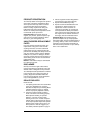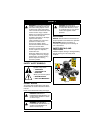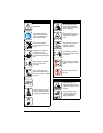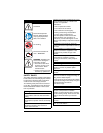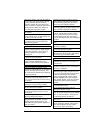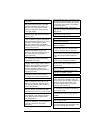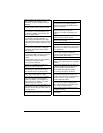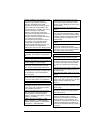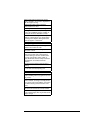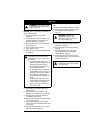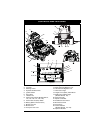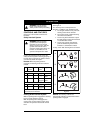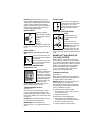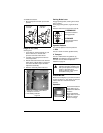
EN - 8
Always keep hands and feet away from all
pinch points.
Avoid slippery surfaces. Be sure of your
footing while using pedestrian controlled
equipment, especially when backing up.
Walk, don’t run. Use extreme caution if
operating on wet grass, reduced footing
could cause slipping.
Never carry passengers and keep pets and
bystanders away. Stop machine if anyone
enters the area.
Be aware of the mower discharge direction
and do not point it at anyone. Never direct
discharged material toward anyone. Avoid
discharging material against a wall or
obstruction. Material may ricochet back
toward the operator. Stop the blade(s) when
crossing gravel surfaces.
Never engage PTO when attachment,
including mower blades, is not in use.
Always turn off power to attachment when
not in active use such as traveling or
crossing driveways.
Slow down and use caution when making
turns and crossing roads and sidewalks.
Stop blades if not mowing.
Stop on level ground, lower implements,
disengage drives, engage parking brake (if
provided), disengage PTO, shut off engine
and allow moving parts to stop before
leaving the operator’s position for any
reason including emptying the catchers or
unclogging the chute.
Never engage PTO while raising the
attachment, including mower blades, or
when attachment is in the raised position.
Never raise deck with the blades running.
Never operate with the PTO shield, or other
guards not securely in place. Be sure all
interlocks are attached, adjusted properly,
and functioning properly. Never modify or
remove safety devices.
Do not mow in reverse unless absolutely
necessary. Always look behind and down
before backing up to be sure of a clear path.
Stop equipment and inspect blades after
striking objects or if an abnormal vibration
occurs. Make necessary repairs before
resuming operations.
Never leave a running machine unattended.
Always turn off blade(s), set parking brake,
stop engine and remove key before
dismounting.
Disengage blade(s) when not mowing. Shut
off engine and wait for all parts to come to a
complete stop before cleaning the machine,
removing the grass catcher, or unclogging
the discharge guard.
Know the weight of loads. Limit loads to
those you can safely control and the unit can
safely handle.
Use care when loading or unloading the
machine into a trailer or truck.
Operating Conditions
Always check overhead and side clearances
carefully before operation.
Watch for traffic when operating near or
crossing roadways.
Ensure the area is cleared of objects such
as rocks, wire, toys, etc., which could be
thrown by the blades prior to operation.
Check for weak spots on docks, ramps or
floors. Avoid uneven work areas and rough
terrain. Stay alert for hidden hazards or
traffic.
Always use ramps to climb curbs to prevent
personal injury or equipment damage.
Use care when approaching blind corners,
shrubs, trees or other objects that may
obscure vision.
Dust, smoke, fog, etc. can reduce vision and
cause an accident.
Only operate in good light, keeping away
from holes and hidden hazards.
Slope Operation
Slopes are a major factor related to loss of
control and tip-over accidents, which can
result in severe injury or death. Operation on
all slopes requires extra caution. If you
cannot back up the slope or if you feel
uneasy on it, do not mow it.
DO NOT operate on slopes of more than
20°. This maximum degree of operation is
without attachments.
Do not operate on slopes of more than 10°
with attachments such as grass catchers
installed.
Mow across slopes, not up and down.
DO NOT operate the mower on slopes at all
when the grass is wet.
DO NOT operate on slopes steeper than
you can feel secure about the traction of the
tires and the stability of the mower.



